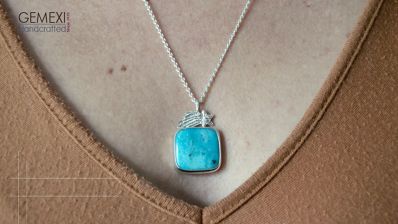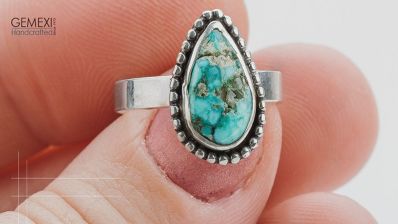Exploring the Rich Tradition of Spiny Oyster Turquoise in Southwestern Style Silver Jewelry
By Gemexi Team | Turquoise- Updated On Jun 15, 2023

Southwestern jewelry, known for its vibrant colors and intricate designs, encapsulates a rich history and diverse cultural influences that have evolved over centuries. Particularly noteworthy is the tradition of incorporating Spiny Oyster Turquoise in silver jewelry, a practice that has been an integral part of Native American craftsmanship.
The spiny oyster, a marine bivalve found predominantly in the warm waters of the Sea of Cortez off the coast of Baja California, has been valued by the Native American tribes for centuries. The inner shell, imbued with hues ranging from crimson to orange and purple, has been incorporated into Southwestern jewelry to create a striking contrast with turquoise stones and sterling silver settings.
Pairing turquoise with spiny oyster in jewelry is a reflection of the rich tapestry of the Southwest landscape. The turquoise stone, with its rich blue-green color, mirrors the expansive desert sky. It's revered by various tribes such as the Navajo, Hopi, and Zuni for its spiritual and symbolic significance, believed to represent health, protection, and prosperity.
On the other hand, the vivid shades of spiny oyster shells evoke the fiery hues of the setting sun. This juxtaposition of cool turquoise with warm spiny oyster resonates deeply with the stark contrasts found in the Southwestern landscape. When these elements come together in sterling silver settings, they showcase the elemental beauty of the region.
The allure of the spiny oyster turquoise combination isn't just limited to its visual appeal. The careful process of sourcing, shaping, and setting these materials speaks volumes about the craftsperson's skill and patience. The crafting of such jewelry is often a time-honored tradition, passed down through generations, carrying with it stories and symbolism specific to each tribe.
In addition to being visually stunning, this style of jewelry is steeped in meaning. The combination of spiny oyster and turquoise is often seen in traditional Southwestern symbolism as representing the unity of sky and earth, water and fire, male and female. This harmony of dualities is a recurring theme in Native American cosmology and philosophy, reminding us of the interconnectedness of all things.
The integration of spiny oyster and turquoise in silver settings showcases a range of techniques and designs distinctive to Southwestern jewelry. These include squash blossom necklaces, intricate inlay work, and detailed stamp work. This versatility in design showcases not only the craftsperson’s skill but also the depth of cultural storytelling within the art form.
Silver, a metal valued for its malleability and brilliant sheen, adds to the aesthetic appeal of these pieces. Native American silversmithing has roots in the late 19th century, when tribes of the Southwest learned the craft from Mexican artisans. Over time, these silversmiths have honed their craft, creating pieces that beautifully frame the turquoise and spiny oyster elements. The silver provides a perfect canvas, allowing the vibrant colors of these natural materials to truly stand out.

In conclusion, spiny oyster turquoise jewelry is more than just a physical ornament. It is a celebration of the Southwestern landscape, a testament to the mastery of the Native American artisan, and a symbol of a rich cultural heritage. Each piece tells a story — of the sky and the earth, the water and the fire, the artisan and their ancestors, coming together to create a testament to an age-old tradition. As such, wearing spiny oyster turquoise in Southwestern style silver jewelry is not only a fashion statement but also a means to connect with the profound history and philosophy of the Southwest.
The spiny oyster, a marine bivalve found predominantly in the warm waters of the Sea of Cortez off the coast of Baja California, has been valued by the Native American tribes for centuries. The inner shell, imbued with hues ranging from crimson to orange and purple, has been incorporated into Southwestern jewelry to create a striking contrast with turquoise stones and sterling silver settings.
Pairing turquoise with spiny oyster in jewelry is a reflection of the rich tapestry of the Southwest landscape. The turquoise stone, with its rich blue-green color, mirrors the expansive desert sky. It's revered by various tribes such as the Navajo, Hopi, and Zuni for its spiritual and symbolic significance, believed to represent health, protection, and prosperity.
On the other hand, the vivid shades of spiny oyster shells evoke the fiery hues of the setting sun. This juxtaposition of cool turquoise with warm spiny oyster resonates deeply with the stark contrasts found in the Southwestern landscape. When these elements come together in sterling silver settings, they showcase the elemental beauty of the region.
The allure of the spiny oyster turquoise combination isn't just limited to its visual appeal. The careful process of sourcing, shaping, and setting these materials speaks volumes about the craftsperson's skill and patience. The crafting of such jewelry is often a time-honored tradition, passed down through generations, carrying with it stories and symbolism specific to each tribe.
In addition to being visually stunning, this style of jewelry is steeped in meaning. The combination of spiny oyster and turquoise is often seen in traditional Southwestern symbolism as representing the unity of sky and earth, water and fire, male and female. This harmony of dualities is a recurring theme in Native American cosmology and philosophy, reminding us of the interconnectedness of all things.
The integration of spiny oyster and turquoise in silver settings showcases a range of techniques and designs distinctive to Southwestern jewelry. These include squash blossom necklaces, intricate inlay work, and detailed stamp work. This versatility in design showcases not only the craftsperson’s skill but also the depth of cultural storytelling within the art form.
Silver, a metal valued for its malleability and brilliant sheen, adds to the aesthetic appeal of these pieces. Native American silversmithing has roots in the late 19th century, when tribes of the Southwest learned the craft from Mexican artisans. Over time, these silversmiths have honed their craft, creating pieces that beautifully frame the turquoise and spiny oyster elements. The silver provides a perfect canvas, allowing the vibrant colors of these natural materials to truly stand out.

In conclusion, spiny oyster turquoise jewelry is more than just a physical ornament. It is a celebration of the Southwestern landscape, a testament to the mastery of the Native American artisan, and a symbol of a rich cultural heritage. Each piece tells a story — of the sky and the earth, the water and the fire, the artisan and their ancestors, coming together to create a testament to an age-old tradition. As such, wearing spiny oyster turquoise in Southwestern style silver jewelry is not only a fashion statement but also a means to connect with the profound history and philosophy of the Southwest.
- Tags:
- Spiny Oyster Turquoise Jewelry
- Spiny Oyster In Jewelry
- In Southwestern Style Silver Jewelry
- Style Of Jewelry
- Southwestern Jewelry










0 Comments
Write Comments